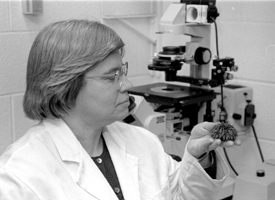The University Record, February 07, 2000 By Sally Pobojewski
News and Information Services

Scientists at the U-M have developed a new cancer-inhibiting peptide, or chain of amino acids, that has proven to be effective at preventing metastatic prostate cancer from spreading to other organs in laboratory rats.
Rats treated systemically with the new peptide developed smaller primary tumors and fewer lung metastases than untreated rats and showed no toxic side effects from the treatment. The peptide was effective even if primary tumors were allowed to grow to a large size before surgery and peptide treatment began. If future studies show the peptide works as well in people, it could be the basis for a new approach to cancer therapy.
In an article published in the Jan. 15 issue of Cancer Research, the scientists present results from an extensive series of experiments that document the peptide’s ability to block cancer cells’ invasive activity and limit the growth and spread of tumors in laboratory rats.
Donna L. Livant created the peptide by changing just one amino acid in a short sequence of a common blood protein called fibronectin, which circulates freely through the body in blood plasma, lymph, serum and interstitial fluid around cells.
When tissue is damaged, fibronectin at the injury site fragments and diffuses outward. Unlike intact fibronectin, which is present everywhere in the body, these fragments bind to fibronectin receptors on cells surrounding damaged tissue, which stimulates them to invade and repair the injury.
The downside to this process, according to Livant, assistant professor of cellular biology, is that cancer cells can mutate so that intact fibronectin stimulates them to invade surrounding tissue also. “Cancer is the price we pay for our ability to heal from wounds,” Livant says. “When intact fibronectin stimulates cancer cells to invade, they can easily reach the blood or lymphatic system and metastasize or spread to other parts of the body.”
In early cell culture studies, Livant discovered that metastatic tumor cells are not invasive unless serum—the fluid component of blood that remains after clotting—is present.
Additional studies showed that plasma fibronectin was the only part of serum required for invasion. Finally, Livant isolated one specific peptide in fibronectin, called PHSRN, that triggered the invasion process.
“This PHSRN sequence on fibronectin fragments binds to the fibronectin receptor on many types of epithelial cells and stimulates them to migrate into damaged tissue,” Livant explains. “Metastatic prostate cancer cells also express the fibronectin receptor, but unlike normal cells, invasion is stimulated when their fibronectin receptor encounters the PHSRN sequence of intact fibronectin. This interaction triggers a process that stimulates malignant cells to invade surrounding tissue, as well as blood and lymphatic vessels. Once tumor cells have entered blood and lymphatic vessels, the process also stimulates them to leave the vessels to colonize distant sites.”
Using knowledge of the biochemistry of the fibronectin receptor site, Livant substituted the amino acid cysteine for arginine in the PHSRN sequence.
Livant tested this new peptide derivative, which she calls PHSCN, on human and rat prostate cancer cell lines in culture and found it to be a powerful cell invasion inhibitor. She then tested it on laboratory rats injected with 100,000 cells from a naturally occurring, metastatic rat prostate cancer cell line called MAT-LyLu, which can kill a rat in just 25 days. Experimental rats in the study received intravenous injections of the new peptide three times each week; control rats received no treatment.
After 16 days of tumor growth and five PHSCN injections, the mean diameter of tumors in treated rats was less than 0.5 mm. The mean diameter of tumors in untreated rats was 1.8 cm., a 2,000-times larger volume. Untreated tumors had more than 10 times the blood vessel density found in tumors from treated rats. This is significant, because tumors must have a blood supply to grow.
To more accurately model clinical situations, Livant did not begin intravenous therapy in another group of rats until after surgically removing their large, primary tumors. Rats in this group, which first received PHSCN 24 hours after surgery, developed 99 percent fewer visible lung metastases and 95 percent fewer microscopic lung micrometastases than rats treated with surgery alone.
Livant says the exact mechanism of PHSCN’s anti-cancer activity remains unknown, although she has several possible explanations she plans to test in future research. Her goal is to discover exactly why this new peptide is so effective at preventing malignant cells from spreading and how it blocks the growth of blood vessels into the primary tumor.
“There appears to be a biochemical ‘on switch’ controlling tumor cell movement, which may be activated by the defective receptor pattern of key receptors on cancer cells,” Livant adds. “Our goal is to learn how to use this new peptide to turn that switch off.”
Co-authors from the Medical School include R. Kaye Brabec, research associate; Kenneth J. Pienta, professor of internal medicine and of surgery; David L. Allen, post-doctoral research associate; Kotoku Kurachi, professor of human genetics; Sonja Markwart, research associate; and Ameet Upadhyaya, research associate.
The U-M holds several patents on the PHSCN peptide related to the diagnosis and treatment of cancer. The study was funded by the March of Dimes, the National Institutes of Health and the Office of the Vice President for Research.

